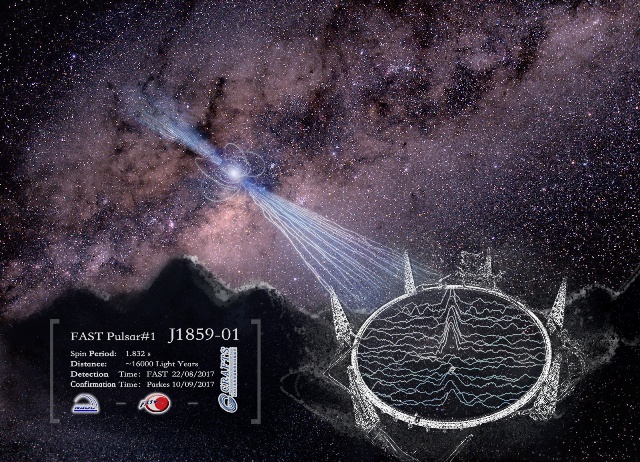

World's largest radio telescope, FAST, discovers new pulsars. (Image by NAOC)
Chinese scientists announced their first discoveries of two new pulsars in the Southern Galactic plane, with the Five hundred-meter Aperture Spherical radio Telescope (FAST), world’s largest single dish radio telescope, on Oct. 10 in Beijing.
Two new pulsars, PSR J1859-01 (FP1 or FAST pulsar #1), and PSR J1931-01 (FP2 or FAST pulsar #2), have just been confirmed by the Parkes telescope in Australia.
FAST, located in Guizhou Province, China, is operated by National Astronomical Observatories (NAOC) of the Chinese Academy of Sciences. The telescope is completed last October. During its first year, FAST has commissioned several observation modes, including pointing, drift scan, and tracking.
Finding new pulsars is one of the key science goals of FAST. The telescope has so far detected dozens of promising pulsar candidates during the commissioning, two of which have been confirmed. These are the first pulsars ever discovered by a Chinese radio facility. The two pulsars were detected in FAST scans on August 22nd and 25th, respectively, and confirmed by the Parkes telescope on September 10th.
“FP1 is a pulsar with a spin period of 1.83 second and an estimated distance of 16 thousand light-years, and FP2, is a pulsar with a spin period of 0.59 second and an estimated distance of 4.1 thousand light-years,” said LI Di, Deputy Chief Engineer of FAST Project and also Chief Scientist of Radio Astronomy Division of NAOC.
Pulsars are rapidly rotating compact stars subject to physical conditions far beyond the reach of any laboratory on Earth. Scientists say that there are a vast number of pulsars in our Galaxy, however, only a small portion have been discovered, since most of them are weak radio sources or masked by radio interference produced by human activities.
Located in a radio quiet zone, FAST is by far the most sensitive radio telescope in the world and an ideal instrument for identifying new pulsars. “The two new discovered pulsars symbolize the dawn of a new era of systematic discoveries by Chinese radio telescopes,” said YAN Jun, director of NAOC.
The pulsar timing array (PTA) experiment attempts to detect low-frequency gravitational waves from merging supermassive black holes using the long-term timing of a selected set of stable millisecond pulsars. FAST is expected to find many millisecond pulsars and contribute significantly to the PTA experiment.
In the next two years, FAST is planning more commissioning until it reaches the designed specifications and gradually becomes an open facility for Chinese and international scholars, according to YAN. The FAST group also plans to conduct further tests and optimization of the survey plan and generate science output along the way.
For more details of the pulsars, please refer to http://crafts.bao.ac.cn/pulsar.

86-10-68597521 (day)
86-10-68597289 (night)

86-10-68511095 (day)
86-10-68512458 (night)

cas_en@cas.cn

52 Sanlihe Rd., Xicheng District,
Beijing, China (100864)

